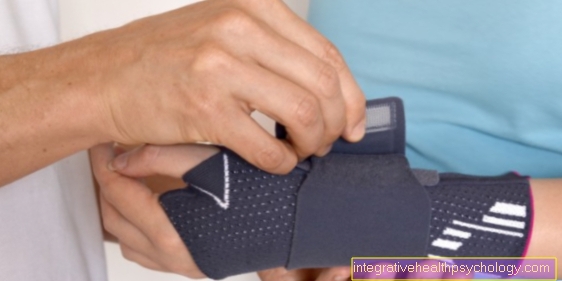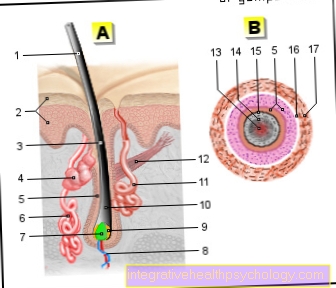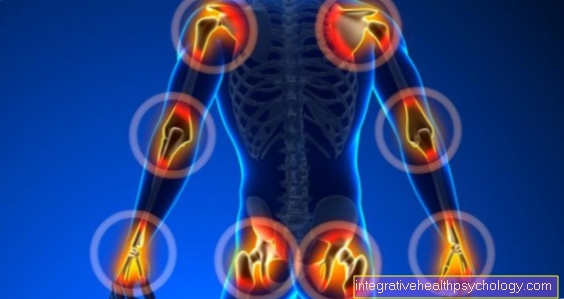Calf wrap against fever
Definition - What are calf wraps?
Most people have probably heard of calf compresses for fever. Especially with children, but also with adults, wraps are an easy-to-use and gentle method of lowering fever.
The method is based on a very simple principle: The wrap is slightly cooler than the patient's skin surface. The warmer skin then causes the water to evaporate, which in turn cools the skin. In this way, the fever can be reduced by 0.5 to 1 ° C, depending on the duration of use.
Further information can also be found here: How can you lower a fever?

How to do calf wraps
Calf wraps are best used when the patient is lying or at least half-lying. Before applying the compress, the fever should be measured and hands and feet checked for temperature.
Read about it too: How can you measure a fever?
Only when hands and feet are warm or even hot can and may calf wraps be used. If this is not the case and the extremities feel cold, the patient is still experiencing a rise in fever. You have to wait until this is finished. Chills can also be a sign of this.
The following utensils are to be provided for the calf wrap:
- two thin (linen) towels
- two towels
- one or two bath towels
- a bowl of lukewarm up lukewarm water for use in children or cool (16-20 ° C) to lukewarm water for use in adolescents and adults.
In the first step, one of the bath towels should be placed under the bed to protect against moisture. Then one of the two thin linen towels is dipped into the bowl with the water and wrung out. It should still be wet, but no longer dripping. This is now wrapped around one and a half times around the patient's lower leg. The dry towel is then attached over this. Both layers should be wrapped tightly so that the cloths lie directly on the patient's skin.
The process is now repeated on the second leg. It is important that the wrap neither covers the knees nor the ankles. These should remain free. As a last step, another bath towel or other thin cloth can be placed loosely around both legs or the patient can be covered loosely with it. Here it must be ensured that no excessively thick cloths or blankets are used, as otherwise a so-called heat build-up can occur. As a result, the fever-lowering effect of the compress can be lost.
How often should you do leg wraps?
Leg wraps are most effective when used three times in a row. A simpler version consisting of two successive passes is also suitable for children.
- With a moderate to high fever it only takes a few minutes for the wraps to come close to the patient's body temperature during the first run.
- The second wrap follows, which should remain on the skin for about ten minutes.
- The third round should then take a maximum of about 20 minutes.
The wraps must then be removed and the patient's skin dried.
Also read: Home remedies for a fever
What temperature should calf compresses be?
Calf wraps can be used with different warm water depending on the age of the patient. For adults, in addition to cold compresses made with water at around 20 ° C, lukewarm compresses are also suitable. Particularly with the cold wraps, care must be taken that the Patient does not begin to freeze.
Cold water should not be used in children. Here you can fall back on lukewarm to lukewarm water. The temperature of the calf wrap is only a few degrees away from the patient's body temperature. Nevertheless, these wraps are effective and are less stressful for the circulation.
Read more on the topic: When should I see a doctor with a fever?
What should be considered with calf wraps & when should they not be used?
Before using leg wraps, it is imperative to check the temperature of the patient's hands and feet. If these are cold or cool, then, as already mentioned, the fever is still rising. Then calf wraps must not be used.
It can only be used on warm or hot extremities. But even then, caution is advised. Patients with circulatory or heart problems should refrain from therapy with calf compresses for safety reasons. Because lowering the fever can strain the circulation. It is therefore important to monitor your circulation during a diaper treatment.
If dizziness or nausea occurs, the compress must be removed immediately. In order to prevent circulatory problems as well as possible, the fever should be measured before and during treatment with calf compresses.
Read also: Fever, dizziness and headache
This can drop by about half a degree to a whole degree Celsius. If the fever is lowered even further, it will put too much strain on the body.
Duration of use - how long will the calf compresses be left on the leg?
When it comes to the duration of use, it should be noted that the compress must be removed immediately if the patient is uncomfortable with them or if he or she starts to freeze during treatment with calf compresses.
Otherwise, the compress should be changed or removed as soon as it has approximately reached the patient's skin temperature. It can easily be felt. However, it should be removed after 20 to 30 minutes at the most, as otherwise the patient's circulation will be too stressed.
How quickly do calf compresses reduce fever?
The effect of calf wraps occurs after a very short time. After using it for about half an hour, as described above, the temperature has usually dropped by half a degree to a whole degree Celsius. After a single application, the temperature should not drop any further. Precisely because the effect of the wrap develops comparatively quickly, prolonged use can otherwise lead to circulatory problems.
What do you have to consider with babies, children and pregnant women?
Special features in babies
In the case of babies, the principle that every fever should first be clarified by a pediatrician is even more important. The use of calf compresses on babies should then be carried out at the earliest from the age of six months. But even with older babies and toddlers, problems often arise with treatment with calf compresses, since many babies do not tolerate the damp compresses or do not hold them on the calves by kicking.
You might also be interested in: Fever suppositories for babies and toddlers
Here, the easier handling with stockings instead of towels is recommended, as already mentioned with the vinegar wraps. These hold better on the lower leg and are not so easy to remove. As with the wraps, a second dry sock is pulled over the damp, no longer dripping and hand-warm sock. Again, it is particularly important that the stockings reach the hollow of the knees, but not above the knee. In babies it is also more difficult to determine whether the application is uncomfortable for the little patient. Parents should watch their baby or toddler during therapy with leg compresses and remove the compresses or socks if their baby is uncomfortable.
More information can be found here: What to do if your baby has a fever
Special features in children
With children, there are a few things to consider before using leg wraps. Since fever is a common sign of infectious diseases, a pediatrician should be consulted first for safety, especially with small children.The doctor can then clarify the cause of the fever and, if necessary, agree to a treatment with calf compresses.
The temperature of the wrap plays a major role in the actual application. With children, the wraps must not be too cold; as already mentioned, lukewarm or at least lukewarm wraps are recommended here. A single change of the compress is often sufficient for children. After another 20 minutes, the compress should be removed and the fever measured again. In children it is particularly important to ensure that the fever is not lowered by more than one degree Celsius. The child must be closely observed during treatment with calf compresses. A parent should be present at all times to identify any symptoms such as feeling unwell or freezing during treatment. Then the calf wraps must be removed.
Learn more about: Fever in the toddler
Special features in pregnancy
During pregnancy, calf compresses are a special alternative to lowering fever, as many antipyretic drugs are either not permitted or not enough research has been done on pregnant women. In addition to the precautionary measures already mentioned before use, such as measuring a fever and determining the temperature of the hands and feet, particular attention should be paid to the circulation in pregnant women.
Caution is advised with fever in and around pregnancies if this occurs suddenly or rises very high, if Fever after scraping occurs and if fever in connection with a milk congestion occurs. In these cases and in general if you are uncertain, you should always consult a doctor.
You'll find more about it here:
- Fever during pregnancy
- Postpartum fever
Leg wrap - variants
Vinegar leg wrap
Vinegar also has antipyretic properties. As with water, you can use diluted vinegar to use calf compresses or so-called vinegar socks to gently lower your fever. To do this, about four to five parts of lukewarm water are mixed with one part of (apple) vinegar. Linen cloths or other thin cloths can be dipped into the mixture, analogous to the application with water. Proceed as with normal calf wraps.
It is also possible to dip a pair of cotton socks in the vinegar-water mixture. These are then also wrung out until they no longer drip and the patient is drawn up over the calves. A pair of dry cotton socks is pulled over it. This method is particularly suitable for babies and toddlers due to its somewhat easier handling.
Of course, special care must be taken to ensure that the patient has warm hands and feet and that the wraps or socks reach far enough over the calves, if possible to the hollows of the knees.
Calf wrap with Retterspitz
Calf wraps can also be used with Retterspitz. Retterspitz contains a mixture of essential oils, such as Bergamot- or Orange blossom oil, and various Medicinal plants, such as arnica, which has been shown to be helpful for blunt injuries or rosemarywhich is used for rheumatic complaints.
In addition to all sorts of other effects, this combination also shows antipyretic properties. Wraps with Retterspitz are also suitable for bruises, strains and other sports injuries or for treating inflammation. The wraps are used in a similar way to vinegar wraps, diluted with water. The rest of the handling corresponds to that of the classic calf wrap.
Leg wrap with curd cheese
Quark compresses are another home remedy that is often used to reduce fever and also to treat minor sports injuries. To do this, a mixture of quark and a little vinegar is applied to a thin linen or cotton cloth. The vinegar makes the quark more spreadable; In addition, as already mentioned, vinegar is also responsible for the antipyretic properties of the quark wrap. The finished wraps are then attached to both lower legs, as described above for the normal calf wraps; in the case of sports injuries such as bruises and sprains, only on the affected leg or arm. The wrap can then be left in place for about half an hour before it is removed and the skin is cleaned with a damp cloth. Here, too, it should of course be noted that quark compresses must not be used to lower the fever when the fever rises.
What are calf wrap hooks?
Calf wrap hooks have less to do with the known calf wraps for lowering fever. They come from the Middle Ages and were intended to stabilize the leggings that men often wore at that time, or to fasten their ends. Today they are rarely found. Leg wrap hooks can only be found as decorations or accessories at medieval markets or festivals.
Recommendations from our editorial team
- How can you lower a fever?
- Causes of fever
- High temperature
- The fever dream
- Pain in the limbs with a fever
- Chest wrap














.jpg)














